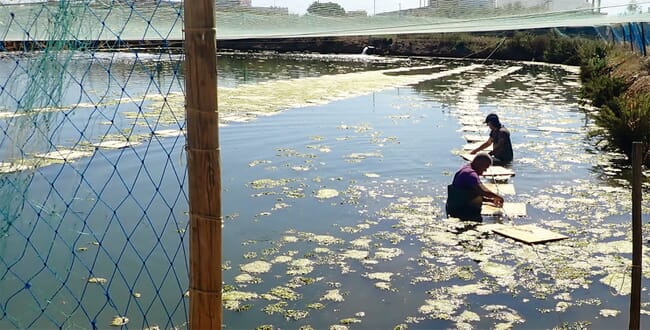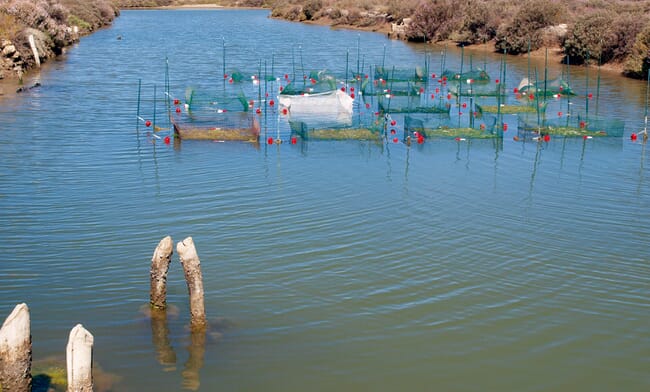Integrated multi-trophic aquaculture principles are a circular economy paradigm that supports more sustainable and competitive activities. Cultivating different aquaculture species from different trophic levels (for example, carnivores, plants, algae or filtering animals) in the same space generates synergies promoting biomitigation and contributing significantly towards the environmental and socioeconomic efficiency of the industry.

However, although integrated multi-tropical aquaculture (IMTA) is being promoted by the main European Union policies, there are still many social, administrative and legal hurdles that do not allow the full development of these production systems. For this reason, a group of European experts has been working together for more than two years to strengthen collaborative networks between the scientific, business and government sectors, in order to valourise all the knowledge acquired and turn this innovative sustainable aquaculture solution into a reality in European Atlantic Area.
In its third and final year of implementation, the Interreg Atlantic Area project Integrate "Integrated Aquaculture: an eco-innovative solution to foster sustainability in the Atlantic Area", has eight case studies spread across three fully operational pilot actions in Spain, France, Portugal and Ireland to develop specific technology and production processes for Atlantic IMTA. "The results of this work will be useful not only at a productive level, but also at a legislative and environmental level, continuously generating knowledge exchange and dissemination impact of the actions carried out", explains María del Mar Agraso, technical director of CTAQUA, Aquaculture Technology Centre, that leads the project.
As part of its action plan, Integrate is also working towards obtaining a definition of IMTA. Earlier this year, the project consortium launched a questionnaire with a specific target audience of experts with direct knowledge or experience of IMTA. "Without a doubt, it is essential to join forces with researchers and producers in order to reach a consensus. After doing so, the main conclusion was that there is a need for a definition of integrated multi-trophic aquaculture, so we set out to work on it," explains María del Mar Agraso.
The next step for the Integrate consortium was to bring together 39 experts from 11 countries in Porto (Portugal) to discuss the final definition of IMTA, and also to identify which factors may be hindering the development of this activity on an industrial scale. Xinhua Yuan (Food and Agriculture Organization of the United Nations, FAO), Amir Neori (University of Haifa), Adam Hughes (Scottish Association for Marine Science), Patricia Bianchi (Aquaculture Stewardship Council) and, with a deferred presentation from Canada, Thierry Chopin (professor at the University of New Brunswick and scientific director of the Canadian Integrated Multi-Trophic Aquaculture Network (CIMTAN)), were the keynote speakers at this event that generated important conclusions regarding the definition of IMTA that Integrate is currently working on.
First of all, the experts conclude that it is possible and necessary to have a single global IMTA definition for all systems, whether freshwater, marine, land-based, open-water, recirculating, flow-through, etc. "It is essential that the definition be broad and all-encompassing so that it can be understood across the board. This simple definition will be accompanied by a technical standard that can be detailed and layered for a more scientific and technical audience. In this way all stakeholder groups will be represented at an appropriate level of detail for their needs, and this will help to guarantee wider adoption of IMTA practices in the European Atlantic Area", explains Adam Hughes.

© CTAQUA
Although integrated systems can also include terrestrial organisms, experts agree that the primary product and core activity must be aquatic, whether it’s fish, invertebrates or algae. In addition, they conclude that there must be a minimum of two categories of organisms and that the energy (food) exchange between them must be intentionally managed.
The second point is that environmental and socio-economic benefits are a very important part of IMTA. However, a debate arose during the event as to whether these benefits should be included in the definition. Some argued that good environmental management, which in this case is represented by IMTA as a form of sustainable aquaculture, positively affects the social and economic system and it would be rather challenging to break these systems apart.
The third conclusion refers to the meaning of Integrated, when speaking about integrated multi-trophic aquaculture. Experts conclude that the direct water connectivity between organisms in the system is more important than the scale at which this connection occurs. This means that water must be transferred from one organism to another without the need for road, rail or aircraft transport; however, absolute co-location in the same licensed site, for example, is not necessary. Once this physical connectivity has been proven, a modelling approach to predict and manage the energy transfer can be used.
And last but not least, the experts agreed that an appropriate legislative framework for IMTA already exists. "We have the necessary tools to adapt the existing regulations and incorporate IMTA into these frameworks when the revision cycle of these regulations takes place. It must be ensured that regulatory frameworks specifically recognise IMTA and support its development," explains Jessica Ratcliff (National University of Ireland, Galway, NUIG).
The possibility of including IMTA in an existing eco-label or having a specific eco-label for IMTA in due course is also envisaged. Although it is not work that will be developed within the framework of this project, Integrate is working on a technical standard that will serve as the basis for this future eco-label, which would allow consumers to easily identify the value and quality of IMTA products.
Through its network of pilot action and pre-commercial IMTA systems the Integrate team is generating more data in order to better inform the development of the standard and provide information for the incorporation of IMTA in the corresponding regulatory framework.
Along with the conclusions drawn from the event held in Porto in May, the four essential factors that the IMTA definition will include are water, functional groups, management of nutrient flux and harvest. "The next challenge is to bring these elements together in a simple yet meaningful definition, in order to obtain support from key players in the industry and policy-making sectors, and as a basis to increase awareness and knowledge about what IMTA means for the sustainability of aquaculture and thus gain support from the general public," concludes Martha Dunbar, Integrate project coordinator (CTAQUA).


